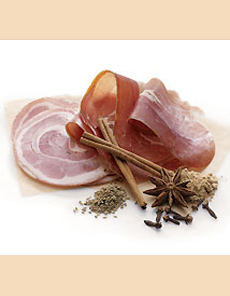TIP OF THE DAY: 10 Spice Blends You Should Know, Part 1
|
Today we present spice blends you should know, even if you aren’t about to use them immediately. Seasonings are the easiest ways to add different flavors to foods. If you’re looking at dieting with a month of broiled chicken or fish, for example, each of these blends will make each plate taste different. While the blends originated in specific countries, they are cross-cultural. You can change the perspective of a classic French dish by adding Indian spices, for example. The basic ingredients and technique are still French, but with a nice touch of fusion flavor. You can also use spice blends in non-traditional ways: to flavor mayonnaise or yogurt or on fruit, for example. Our tip is to be adventurous with spices and conquer the world. (At least, the culinary world.)* Several months ago in the New York Times, Mark Bittman recommended making your own spice blends. He recommends whole spices, which are typically of better quality than ground spices, and stay fresh longer in their whole state. If you buy them in bulk, they can be surprisingly inexpensive. You can give what you don’t need as gifts to friends and neighbors, and you may still be ahead. Check at local international markets, on Amazon.com or the websites of specialists like Penzeys. Their website has plenty of options, but is surprisingly bare-bones, with no photos of the spices. For beautiful spice photos, check out SilkRoadSpices.ca, a Canadian e-tailer. |

Chinese Five Spice, used to cure artisan pork. Photo courtesy McCormick. |
|
|
_____________ *Mark Bittman advises: “…don’t feel as if you have to relegate these mixtures solely to their original uses, like jerk spice on chicken or garam masala in curry. Rub them on meat, poultry, seafood, tofu, or vegetables before grilling, broiling, or roasting; cook them in oil or butter to begin braises or stir-fries; or just sprinkle them on almost anything. My recently regenerated enthusiasm for these came about when I sampled a couple of blends on raw apple slices with ice cream, which was transformational.” You can blend and then grind your spices as needed. This is traditionally done with a mortar and pestle, but you can repurpose an old coffee grinder just for spices. First, clean it and then fill it with raw white rice; grind and then toss the rice. If you still find a residual coffee aroma, do it again. You’ll get more flavor from your spices if you toast them first. Place them whole in a small skillet over medium heat. Shake the pan occasionally until the fragrance rises, 2 to 5 minutes. Cool for a few minutes, then grind. Store all ground spices in tightly sealed jars in a dark, cool place. While some will keep well for months, for the most potency make only what you need for a few weeks. Here are the first five spice blends: adobo from Mexico, chili powder from Mexico, five spice from China, garam masala from India, and jerk from Jamaica. |
||
 Garam masala, an Indian spice blend that varies by region and individual cook. Photo courtesy SilkRoadSpices.ca. |
ADOBO Adobo is a popular Mexican spice mix: spicy and rich in flavor, but not hot. Traditional blends have no added salt. People on low-salt diets can use it in place of salt (but check the label). There are different strengths of chili powder, depending on the heat of the chiles used. Some are labeled medium or hot. |
|
|
CHINESE FIVE SPICE Five spice powder is a versatile Chinese seasoning. The five spices vary by region and individual preference. As with other all-purpose spice blends, including curry and Chinese five spice, the ingredients in this Indian spice vary by region and individual cook. Jerk seasoning is a hot Jamaican spice blend. There are different jerk blends for chicken, fish, and pork. CHECK OUT WHAT’S HAPPENING ON OUR HOME PAGE, THENIBBLE.COM. |
||


